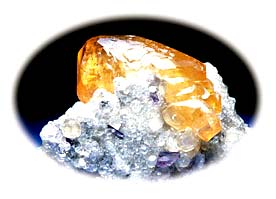This investigation will help you to:
- Learn more about types of minerals.
- Learn more about hardness.
- Learn more about color.
- Learn more about luster.
- Learn more about streak.
- Learn more about specific gravity.
- Learn more about cleavage.
- Learn more about crystal shape.
- Learn more about other properties.
- Learn more about mineral distribution.
- Learn more about mixtures.
Minerals by Name, The Mineral Gallery
Full color images of minerals along with descriptions of physical properties, history of discovery, and more are offered at this site.
Minerals by Physical and Optical Properties, Webmineral
Minerals are listed according to hardness, streak, luster, density, and cleavage and fracture at this web page. Click on the property to view a mineral list. You can then click on individual minerals to view more information and images.
Mineral Hardness, Webmineral
This site defines hardness and provides an interactive table showing Moh's relative hardness scale whereby you can explore the unique properties of many minerals traditionally used in this scale.
Moh's Scale, Jo Edkins
This graphically-enhanced collection rank minerals according to hardness using Moh's scale. It also provides links if you wish to find more about specific minerals and their properties.
Color in Minerals, Webmineral
Explore the three common terms used to identify the coloration of minerals. An interactive table of minerals (sorted by color) and information on individual minerals are also offered at this page.
Color, Project Alert NASA/OSU
See for yourself why color is not always a good indicator of a mineral by this link.
Color in Minerals, Webmineral
Explore the three common terms used to identify the coloration of minerals. An interactive table of minerals (sorted by color) and information on individual minerals are also offered at this page.
Color, Project Alert NASA/OSU
See for yourself why color is not always a good indicator of a mineral by this link.
Luster, University of Oklahoma
Access pictures and definitions of minerals possessing metallic, shiny, glassy, and earthy lusters at this site.
Streak, San Diego Natural History Museum
Learn more about the streak property of minerals
Streak, Project Alert NASA/OSU
Explore examples of streak and streak color for a few common minerals by exploring this site.
What is Specific Gravity?, Amethyst Galleries, Inc.
To learn more about specific gravity and how it is used as a tool to identify minerals from one another, visit this site. It provides two lists of specific gravity values for minerals, one for nonmetallic and the other for metallic minerals.
Specific Gravity, Project Alert NASA/OSU
This site offers a clear and concise definition of specific gravity as well as offers a quick way of determining its value.
Notes On Specific Gravity, Brain Press Publications
Are you looking for a more advanced resource on specific gravity? If so, look no farther. This site include information on the history of thought on specific gravity, how it is calculated, and causes of error in its calculation.
Fracture and Cleavage, Daniel Hogan
A basic overview of fracture and cleavage is available here. It provides visualizations that may help you understand how to identify cleavage.
What is Crystal Cleavage?, Amethyst Galleries, Inc.
A more in depth look into fracture and cleavage is provided in this site. Information is offered on the relationship between cleavage and crystal shape as well as strategies for recognizing mineral cleavage. It also provides an online photo gallery of minerals and includes information on the various types of cleavage each mineral possesses.
Minerals, Crystals and Their Systems, Brain Press Publications
Conceptualizing crystalline structures of minerals can be difficult. Visit this site for an introductory look into this science.
The Fluorescent Minerals, Amethyst Galleries, Inc.
Do you know why some minerals tend to glow when the lights are off? Explore
Mineral Striations, Amethyst Galleries, Inc.
Visit this site to learn about mineral striations and what these striations indicate.
U.S. Mine and Mineral Processing Plant Locations -Maps (Other than crushed stone, sand and gravel, and common clay), USGS
- Two map types are available for download here: one is a low-resolution GIF image of the entire US with the mine and mineral processing locations marked and the other is a high-resolution, twelve-tile mosaic featuring the same information.
- The site also provides maps on agricultural minerals operations, coal mines and facilities, construction minerals operations, excluding crushed stone, sand and gravel, and common clay, and others.
Mixture Basics, Andrew Rader Studios
Click here to access an overview of mixtures. This page uses both the contents within concrete and seawater to demonstrate properties of a "mixture".
Mixtures and Compounds, RCN Corporation
Discover the differences between mixtures and compounds by visiting this page. It also provides information on the properties of mixtures and compounds and mixture separation.

